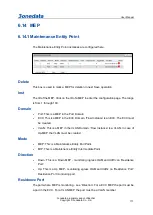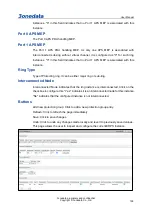
User Manual
3onedata proprietary and confidential
Copyright © 3onedata Co., Ltd.
184
Priority
The priority to be inserted as PCP bits in TAG (if any).
Peer MEP
The TST frame destination MAC will be taken from the 'Unicast Peer MAC'
configuration of this peer.
Rate
The TST frame transmission bit rate - in Mega bits pr. second. Limit is 400 Mbps. This
is the bit rate of a standard frame without any encapsulation. If 1 Mbps rate is selected
in a EVC MEP, the added tag will give a higher bitrate on the wire.
Size
The TST frame size. This is entered as the wanted size (in bytes) of a un-tagged frame
containing TST OAM PDU - including CRC (four bytes).
Example when 'Size' = 64 => Un-tagged frame size = DMAC(6) + SMAC(6) + TYPE(2)
+ TST PDU LENGTH(46) + CRC(4) = 64 bytes
The transmitted frame will be four bytes longer for each tag added - 8 bytes in case of
a tunnel EVC.
There are two frame MAX sizes to consider.
Switch RX frame MAX size: The MAX frame size (all inclusive) accepted on the switch
port of 9600 Bytes
CPU RX frame MAX size: The MAX frame size (all inclusive) possible to copy to CPU
of 1526 Bytes
Consider that the Peer MEP must be able to handle the selected frame size. Consider
that in order to calculate the 'RX rate' a received TST PDU must be copied to CPU
Warning will be given if selected frame size exceeds the CPU RX frame MAX size
Frame MIN Size is 64 Bytes.
Pattern
The 'empty' TST PDU has the size of 12 bytes. In order to achieve the configured frame
size a data TLV will be added with a pattern.
Example when 'Size' = 64 => Un-tagged frame size = DMAC(6) + SMAC(6) + TYPE(2)
+ TST PDU LENGTH(46) + CRC(4) = 64 bytes
The TST PDU needs to be 46 bytes so a pattern of 46-12=34 bytes will be added.
All 0: Pattern will be '00000000'
All one: Pattern will be '11111111'
10101010: Pattern will be '10101010'






























